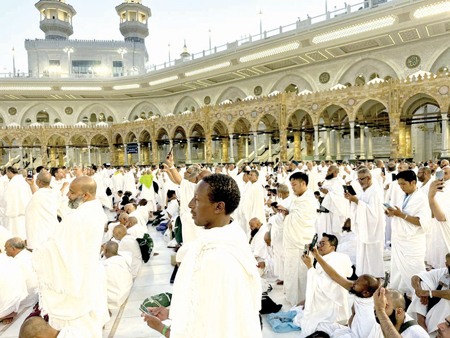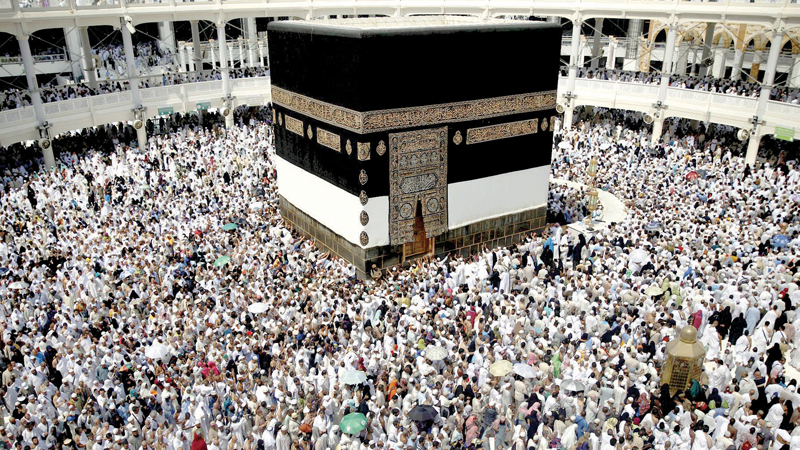Each year, millions of Muslims from across the globe gather in the Kingdom of Saudi Arabia (KSA) to perform Hajj, the holy pilgrimage to Mecca that represents one of the five Central Pillars of Islam.
They are the core obligations that all Muslims must follow: the declaration of faith (Shahada), the daily prayer (Salah), alms-giving and sharing with the poor (Zakat), fasting during Ramadan (Sawm), and the pilgrimage to Mecca (Hajj). These pillars form the foundation of Islamic practice and guide Muslims in living a life dedicated to Allah.
The Hajj follows the Islamic lunar calendar, and its dates vary each year. In 2025, it is expected to start on the evening of June 4 and end on June 9 or 10, depending on the sighting of the New Moon. The Hajj occurs once a year during the lunar month of Dhul-Hijja, the 12th and final month of the Islamic calendar year.
The Hajj is not merely a physical journey, but a profound spiritual awakening—an act of devotion, equality and renewal. For many pilgrims, Hajj is the fulfillment of a lifelong dream, one that requires months, if not years, of planning, saving and spiritual preparation.
Muslim pilgrims converging on Saudi Arabia fulfill a religious obligation, immersing themselves in what can be a spiritual experience of a lifetime for them and a chance to seek God’s forgiveness and the erasure of past sins. The Hajj continues to hold enormous religious, social and emotional significance for Muslims.
The Hajj is the annual Islamic pilgrimage to Mecca in Saudi Arabia and involves a series of religious rituals. It is required once in a lifetime of every Muslim who can afford it and is physically able to make it. Some Muslims make the journey more than once. However, the pilgrimage to Mecca can be made at any time of the year (called Umrah), but it does not carry the same weight or significance for many pilgrims like the Hajj.
When the Hajj falls during the summer months, the intense heat can be especially challenging. According to the Saudi authorities, amid extreme high temperatures last year, more than 1,300 people died during the Hajj. The country’s Health Minister said that the vast majority of the fatalities were unauthorised pilgrims who walked long distances under the Sun.
In view of such incidents, Saudi Arabia strictly controls the number of visas issued to pilgrims from all over the world, with each country getting a quota which cannot be exceeded. This year, more than 1.3 million pilgrims have arrived in Mecca from all over the world. Entry to Mecca is generally granted only for Muslims, unless under extraordinary circumstances.
This year, Saudi Arabia has announced additional measures and facilities at Mecca for the convenience of pilgrims including cooling stations with mist sprays and shade zones, distribution of free water bottles, umbrellas, and hydration solutions, special tracking bracelets for elderly pilgrims to monitor health and location and electronic permit systems to control crowd flow and prevent unauthorised pilgrims.
In the run-up to this year’s Hajj, the Saudi authorities launched a widespread crackdown on unregistered worshippers – relying on frequent raids, drone surveillance and a barrage of text alerts focused on expelling unauthorised visitors hoping to sneak into Mecca. Along with hefty fines, those found illegally entering Mecca during the Hajj face a potential 10-year ban from the KSA.
Over 30,000 health workers will be at the site and there is a 5,000-bed hospital nearby that caters especially to pilgrims during the Hajj period.
The latest Artificial Intelligence (AI) software will also help monitor the flood of information and footage, including video from a new fleet of drones, from across Mecca to better manage the mammoth crowds.
In 2025, over 180 countries are participating, with Indonesia, India, Pakistan and Bangladesh receiving the largest quotas. Pilgrims must apply for Hajj permits through official Government channels. This year, the Hajj Smart App will help pilgrims with navigation, real-time updates, multilingual support and emergency contact assistance.

Performing the Hajj fulfills a religious obligation and is also a deeply spiritual experience
For pilgrims, performing the Hajj fulfills a religious obligation and is also a deeply spiritual experience. It is seen as a chance to seek God’s forgiveness for past sins, to grow closer to God and to walk in the footsteps of prophets. It is rooted in events dating back over 4,000 years in Islamic history.
Communally, the Hajj unites Muslims of diverse races, ethnicities, languages and economic classes from around the world in performing religious rituals and acts of worshipping God at the same time and place. This leaves many feeling a sense of unity, connection, humility and equality. Pilgrims also show up with their own personal appeals, wishes and experiences. Many pilgrims bring with them prayer requests from family and friends that they would like to be said on their behalf.
Some spend years hoping and praying to perform the Hajj or saving money and waiting for a permit/visa to embark on the trip one day.
Ahead of the journey, preparations may include packing essentials for the physically demanding trip, seeking tips from those who have performed the pilgrimage before, attending lectures or consulting other educational material on how to properly perform a series of Hajj rituals as well as spiritually readying oneself.
Pilgrims make the intention to perform the Hajj and they enter a state of “ihram.” Being in ihram includes abiding by certain rules and prohibitions. For instance, men are told not to wear regular sewn or stitched clothes that encircle the body, such as shirts, during ihram. Instead, there are simple ihram cloth garments for men. Islamic scholars say the purpose is to discard luxuries and vanity, shed worldly status symbols and immerse the pilgrim in humility and devotion to God. At Mecca, everyone is the same and equal in the eyes of Allah.
A spiritual highlight of the Hajj for many is standing on the Plain of Arafat, where pilgrims praise God, plead for forgiveness and make supplications. Many raise their hands in worship with tears streaming down their faces.
Other rituals include performing the “tawaf,” circumambulating, or circling the Kaaba in Mecca counterclockwise seven times. The Kaaba, a cube-shaped structure, is the focal point towards which Muslims face during their daily prayers from anywhere in the world. There are many smartphone apps that pinpoint its direction from anywhere for the convenience of the faithful. Among other rituals, pilgrims also retrace the path of Hagar, or Hajar, the wife of Prophet Ibrahim, (Abraham to Jews and Christians), who Muslims believe ran between two hills (called Safa and Marwa) seven times searching for water for her son.
Eid al-Adha, or the “Feast of Sacrifice,” is the Islamic holiday that begins on the 10th day of the Islamic lunar month of Dhul-Hijja, during the Hajj.
A joyous occasion celebrated by Muslims around the world, Eid al-Adha marks Ibrahim’s test of faith and his willingness to sacrifice his son as an act of submission to God. As pilgrims return from Mecca, they are often referred to as “Hajji,” carrying newfound wisdom and renewed faith. Muslims who have performed the Hajj can use the prefix Al-Haj before their name, signifying that they have fulfilled a major obligation as a faithful Muslim.




